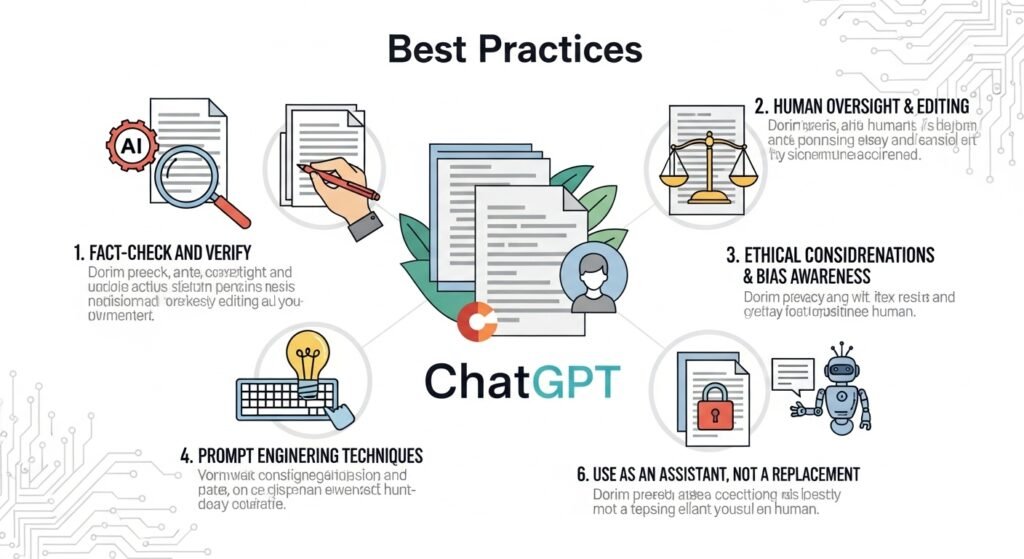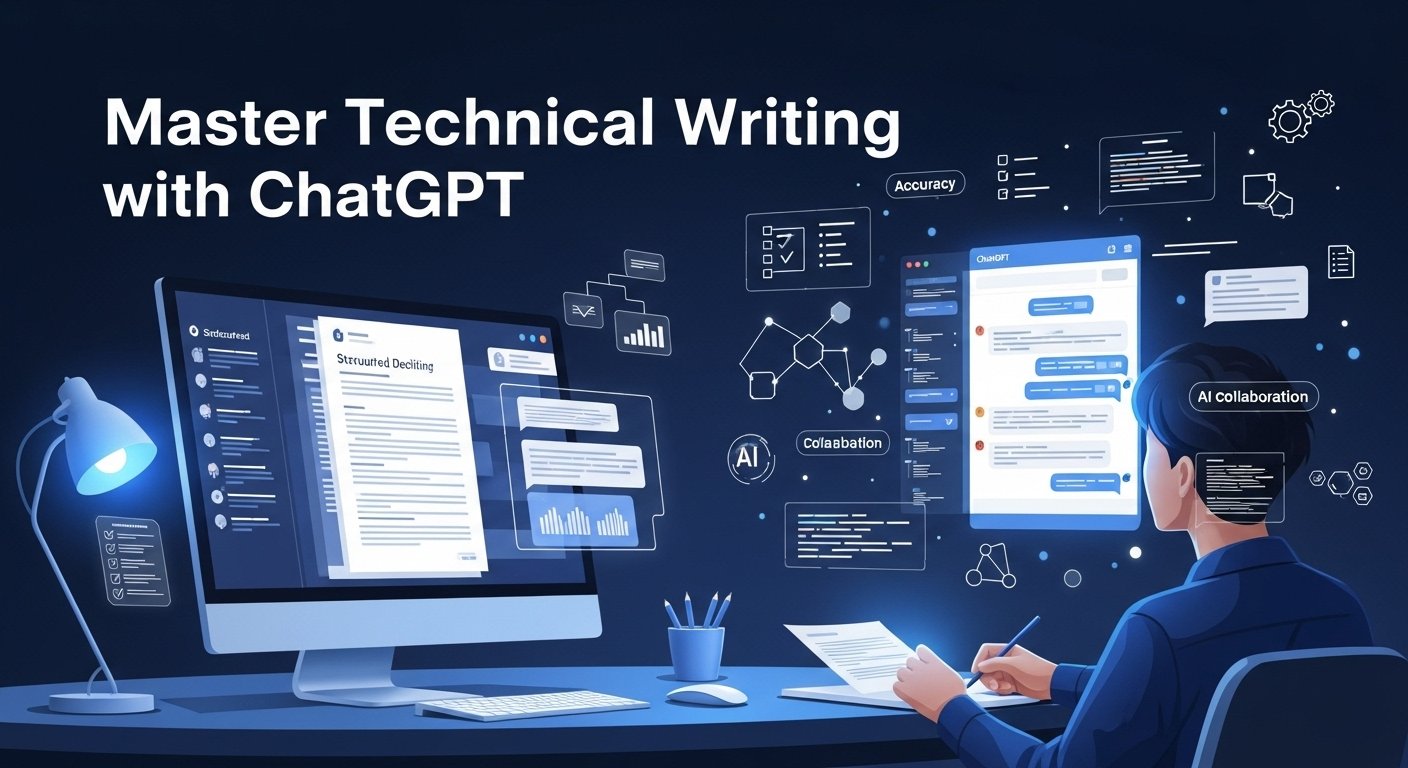Technical writing is vital in industries like software development, manufacturing, and IT. It creates clear, concise, and accurate documentation to help users understand complex products or processes. With artificial intelligence (AI) tools like ChatGPT, technical writers can streamline their workflows, save time, and produce high-quality content.
What is ChatGPT and How Can It Be Used in Technical Writing?
ChatGPT is an AI language model developed by OpenAI. It generates human-like text based on user input, making it a versatile tool for technical writing. As of August 2025, ChatGPT remains a leading AI tool, with updates like GPT-4o enhancing its capabilities for text generation and analysis (OpenAI’s ChatGPT Page).
Applications in Technical Writing
ChatGPT can assist with various tasks:
- Drafting Content: Generate initial drafts of user manuals, tutorials, or FAQs.
- Creating Outlines: Suggest section headings and content flow for structured documentation.
- Editing and Refining: Simplify complex jargon or improve clarity of existing text.
- Brainstorming Ideas: Offer fresh perspectives on explaining technical concepts or addressing user questions.
For example, you can prompt ChatGPT with “Write a step-by-step guide for setting up a new software tool” or “Create an FAQ section for a user manual.”
How to Use ChatGPT for Creative Writing
Benefits of Using ChatGPT for Technical Writing
ChatGPT offers several advantages for technical writers:
- Time-Saving: It generates drafts quickly, reducing the time spent on initial writing. A software company reported cutting documentation time by over 50% using ChatGPT for user manuals (Promptsty).
- Consistency: Maintains a uniform tone and style across documents, which is critical for professional documentation.
- Accessibility: Simplifies technical terms, making content easier for non-technical audiences to understand.
- Idea Generation: Provides creative suggestions for explaining complex concepts or structuring content.
Limitations and Challenges of Using ChatGPT
Despite its benefits, ChatGPT has limitations that require careful management:
- Accuracy: It may generate incorrect or outdated information. For instance, it might invent non-existent product features, as noted in community discussions (Richard Rabil, Jr.).
- Lack of Context: ChatGPT lacks real-time data or proprietary company knowledge, limiting its ability to address specific or recent developments.
- Over-Reliance: Excessive dependence on AI could weaken critical thinking and writing skills.
- Ethical Concerns: Using AI-generated content raises questions about authorship, intellectual property, and compliance with standards like GDPR (Technewscap: ChatGPT GDPR Compliance).
Best Practices for Using ChatGPT in Technical Writing

To maximize ChatGPT’s potential while addressing its limitations, follow these best practices:
- Use Specific Prompts: Craft detailed prompts to guide ChatGPT. For example, instead of “Write a user manual,” use “Write a user manual for a smartphone, including sections on setup, features, and troubleshooting.”
- Edit and Verify: Always review ChatGPT’s output for accuracy and alignment with your organization’s standards, such as the Microsoft Technical Writing Style Guide (Microsoft Style Guide).
- Combine with Human Expertise: Use ChatGPT for initial drafts or inspiration, but rely on human writers for depth, context, and creativity.
- Stay Updated: Monitor updates to ChatGPT, such as GPT-4o, to leverage new features and improvements (Technewscap: Latest Version of ChatGPT).
Example Prompts for Technical Writing
| Task | Prompt Example |
|---|---|
| Drafting a User Manual | “Write a user manual for a smart thermostat, including sections on installation, operation, and troubleshooting, aimed at non-technical users.” |
| Simplifying Jargon | “Rewrite this technical paragraph to be clear and understandable for a general audience: [insert paragraph].” |
| Creating an Outline | “Generate an outline for a tutorial on setting up a secure network, including key sections and subtopics.” |
| Editing Content | “Refine this draft to improve clarity, remove jargon, and ensure it follows the Microsoft Technical Writing Style Guide: [insert draft].” |
Is ChatGPT Suitable for Professional Writing?
Case Studies: Real-World Examples of Using ChatGPT
Software Company Efficiency
A software company used ChatGPT to generate initial drafts of user manuals. Technical writers then edited the content for accuracy and completeness, reducing documentation time by over 50%. This allowed the team to focus on complex tasks like user testing and content strategy (Promptsty).
Step-by-Step Equipment Guide
A technical writer used ChatGPT to create a step-by-step guide for setting up new manufacturing equipment. By providing a specific prompt, such as “Write a guide for assembling a 3D printer, including safety tips,” the writer produced a clear, user-friendly document that was well-received by end-users.
The Future of Technical Writing with ChatGPT
As AI technology advances, ChatGPT and similar tools will become more integrated into technical writing workflows. Updates like GPT-4o, released in 2024, have improved text generation and analysis capabilities, making AI even more useful (Technewscap: ChatGPT 4o Analysis). However, AI is unlikely to replace human writers entirely. Technical writing involves relationship-building, user empathy, and project management—skills AI cannot replicate (Reddit: Technical Writing).
The future will likely involve collaboration, where AI handles repetitive tasks like drafting and outlining, while humans provide critical thinking, context, and creativity. Companies must balance AI’s efficiency with human oversight to maintain quality and ethical standards.
Conclusion
ChatGPT is a powerful tool for technical writers, offering time-saving benefits, consistent tone, and simplified explanations. However, its limitations, such as potential inaccuracies and lack of context, require careful management. By using specific prompts, verifying output, and combining AI with human expertise, technical writers can enhance productivity and create high-quality documentation. As AI evolves, it will play a growing role in technical writing, but human oversight will remain essential for accuracy and creativity.
